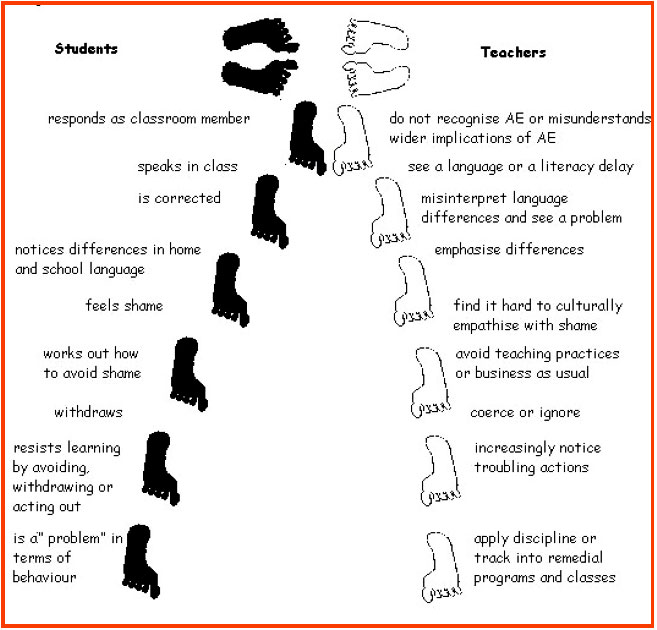For Koorie people, language is culture. Accepting the home language in the classroom reinforces and strengthens their cultural identity. The promotion of a strong first language or dialect (i.e. Koorie English) converts into a strong second language or dialect (i.e. Standard Australian English). There is also a direct correlation between the acceptance of a student’s home language and their engagement and wellbeing – this frequently translates into attendance and achievement at school.
The first dialect as a foundation to learning
A child’s earliest experiences with language form the base on which all future language and literacy learning is developed. These language experiences frame how a student learns about, and engages with, the world around them. It is crucial for teachers to recognise this language foundation as a base for understanding Standard Australian English and finding success in the classroom.
For a Koorie English speaker to find success in the classroom, they must ‘code-switch’ from Koorie English (their first language) to Standard Australian English (the language of the classroom). If Koorie English is valued and respected, Koorie students will be more confident to speak and write in the classroom, which is essential for learning how to code-switch.
Perceptions of language
Teachers play a crucial role in creating a culturally safe learning environment for Koorie students. If Koorie English is valued in the classroom, the student will feel that they are valued too. This will allow them to feel more confident to speak and write in the classroom. A Koorie student will also observe how students of other language backgrounds are treated to decide if they feel safe to participate in the classroom.
If Koorie English is treated as a ‘bad form’ of English, it can have a negative impact on the student. The image below outlines how disengagement can result from a limited understanding of Koorie English and the student’s abilities.
 (Simpson, Munns and Clancy 1999, p.4)
(Simpson, Munns and Clancy 1999, p.4)
Language tracks: Aboriginal English and the classroom; Figure 3: Different and ultimately diverging language tracks
Shame
In Koorie culture, ‘shame’ refers to the feeling of embarrassment from gaining attention in an undesirable way. A student may refuse to participate in activities that draw attention to differences between themselves and others, especially in writing and speaking activities where their differences are noticeable to others. Avoidance of particular classroom activities for fear of shame may be misinterpreted as laziness or disinterest.
Teachers can create an inclusive space for Koorie English speakers by:
- Accepting student responses in Koorie English
- Not making assumptions about student capability based on language skills
- Reinforce Koorie English as a legitimate dialect and not as a ‘bad’ form of English
- Ensure access to books that are written and illustrated by Koorie people so students see that their culture is accepted and respected in the classroom.
Code-switching with confidence
Code-switching is the process of switching from one dialect or language to another depending on the situation. This is related to ‘Translanguaging’ in current research. Explicitly teaching the features and conventions of Standard Australian English will allow the student to identify the differences between the two language systems. A deeper understanding of language features results in greater control and effectiveness when code-switching between Standard Australian English and Koorie English.
 Figure 1 shows the steps that students can take in being able to successfully code-switch from Koorie English to Standard Australian English.
Figure 1 shows the steps that students can take in being able to successfully code-switch from Koorie English to Standard Australian English.
The use of English as an Additional Language (EAL) teaching strategies will assist students in using their base language to better understand Standard Australian English. Although command of Standard Australian English correlates with academic success, promoting and utilising Koorie English allows the student to maintain their cultural identity.
Did you know?
A first language speaker needs at least 3 seconds to respond to a teacher’s question. This should be at least doubled or tripled for English as an Additional Language students.
For an English as an Additional Language student to gain proficiency in Standard Australian English takes approximately
- 3-5 years for interpersonal communication skills (everyday playground language)
- 5-7 years to develop proficiency in academic language (content-background classroom language)
Classroom practice advice
- Teachers have two equally important roles to play in supporting Koorie English speakers in the classroom:
- recognising and valuing Koorie English
- helping students understand Standard Australian English in order to become effective code-switchers
- Koorie English is an expression of culture and identity, and is integral to a student’s sense of wellbeing.
- Recognising the home language or dialect in the classroom supports better attendance and educational achievement.
- Koorie English speakers may need additional processing time when responding to questions or instructions from a teacher.
- Effective 'Code-switching’ between Koorie English and Standard Australian English requires a strong understanding of the features of both dialects.
- Utilise opportunities for students to speak Koorie English in the classroom to enhance their learning and self-esteem.
- Awareness of Koorie English will help change perceptions of the dialect in the school and community.
References
Berry, R. & Hudson, J. (1997). Making the jump: A resource book for teachers of Aboriginal students. Broome: Catholic Education Office
Simpson, L., Munns, G. & Clancy, S. (1999) Language tracks: Aboriginal English and the classroom. PEN 120. Primary English Teaching Association.